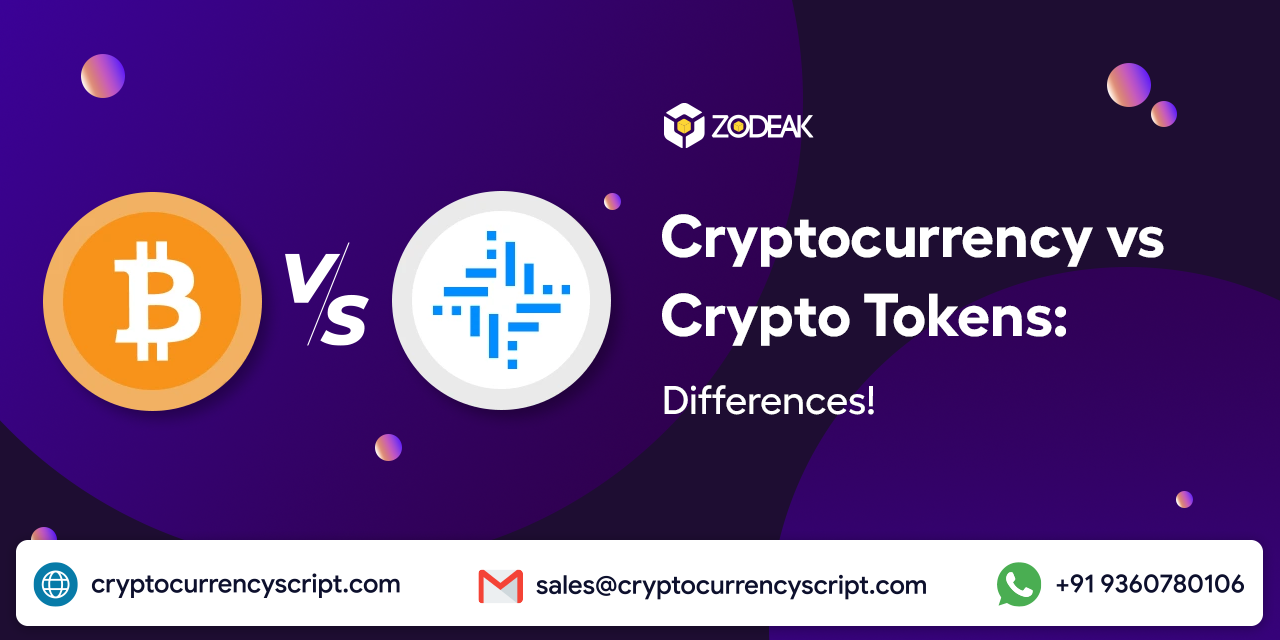Cryptocurrency vs. Crypto Tokens: Differences!
Knowing the distinctions between digital assets cryptocurrency vs. crypto tokens is important if you’re new to blockchain technology and cryptocurrencies. Despite the frequent overlap in usage, there are many significant differences between these phrases.
Generally, an item that is not physical and is created, exchanged, and kept digitally is referred to as a digital asset. Well, the tokens and cryptocurrencies are examples of digital assets in the blockchain.
Crypto tokens and cryptocurrencies are completely unique subclasses of digital assets that make use of cryptography. Cryptography is a sophisticated encryption method that eliminates the chance of double-spending or counterfeiting and ensures the legitimacy of crypto assets.
Crypto tokens like the Ethereum ERC-20 tokens that comprise the Ethereum ecosystem are created as part of a platform that is built on an existing blockchain. However, cryptocurrencies like BTC or ETH are the native assets of a blockchain. This is the primary difference between these two classes of digital assets.
Cryptocurrency
Cryptocurrency is referred to as a native digital asset because it powers a network of blockchain. There is just one native cryptocurrency used to measure network activity on each blockchain. Examples of native cryptocurrencies are Bitcoin(BTC) on the blockchain network, ether(ETH) on Ethereum, and Solana(SOL). The idea behind this is compatible with national reserve currencies found in many countries. For instance, In the US value is expressed in US dollars.
Blockchain Need Cryptocurrencies
Blockchains use cryptocurrencies as a means of rewarding people, teams, and occasionally even entire organizations for managing the network. It’s useful to understand the overall operation of blockchain to comprehend the need for financial incentives.
As a distributed database, a blockchain is housed on a computer located all over the world. The “nodes” of the blockchain are these computers which could even be found in a person’s house. Because of this data distribution—which is essential to the “web3” version of the internet—operating node costs are also distributed.
On the other hand, databases, websites, and apps frequently reside on centralized servers in the Web 2.0 version of the internet. The servers are also paid for by the business that maintains the database, website, or service.
Hardware and power are expensive components in running nodes. Thus, to encourage users to run nodes, blockchain networks require a payment system. Every blockchain has its cryptocurrency to cover the costs of node operators and their labor in processing, validating, and adding new transactions. There is just one native blockchain for this cryptocurrency(such as SOL or BTC).
Popular Cryptocurrencies
Bitcoin – Launched in early 2009 by the enigmatic “Satoshi Nakamoto”. It is the world’s first and foremost cryptocurrency. Because of its early advantage, it has grown to be the most valuable cryptocurrency.
Ether – One of the most widely used cryptocurrencies and something more than that. Thousands of blockchain projects and NFTs(Non-fungible tokens) are now housed on Ethereum as a result of the development and use of smart contracts. In a sense, it forms the spine of the blockchain revolution.
Cardona – A decentralized and open-source blockchain technology that gained recognition as a green cryptocurrency by being among the first to operate on a proof of stake(PoS) consensus. Charles Hoskinson, a co-founder of Ethereum founded Cardona in 2015. With its coin ADA, Cardona enables Peer-to-Peer(P2P) transactions.
Crypto Tokens
Crypto tokens are created using blockchain technology, just as cryptocurrencies, although they aren’t native to a blockchain. Rather, they are constructed upon it, frequently employing smart contracts to accomplish a range of objectives. Crypto tokens are more akin to assets or even deeds than cryptocurrency which resemble conventional money. A crypto token can stand in for a tangible item, a digital product or NFT, or even a portion of ownership in a DAO. Although they aren’t used as a medium of exchange, crypto tokens can be purchased, sold, and exchanged just like currencies. Using an actual example, crypto tokens resemble coupons or vouchers and cryptocurrencies resemble dollars and cents.
Crypto tokens come in many different varieties. Certain governance tokens provide voting rights within a DAO. Access to certain services or goods created by the token issuer can be possible with utility tokens. Security tokens behave and are regarded by many governing bodies in the same manner as conventional securities.
A decentralized app(dApp) or blockchain project is the intended use case for most crypto tokens. Tokens are made and distributed by the project developer, unlike cryptocurrency which is extracted through mining. Tokens have a plethora of uses once they are in the possession of buyers.
Cryptocurrency vs. Crypto Token Differences
Cryptocurrency vs. Crypto tokens differ substantially from one another.
All cryptocurrencies work towards the same goal which is to make blockchain security and network activity easier. As a result, nodes are encouraged to maintain the network and the chain remains commercially viable. In these procedures, tokens are not used.
Tokens are often used for purposes other than merely storing and exchanging value, in contrast to cryptocurrencies. They can be used to represent a variety of things such as blockchain-based copies of real-world assets like the US dollar, digital collectibles in the form of NFTs, or decentralized voting rights. Because of their many applications and relative simplicity in construction, crypto tokens are also significantly more common than cryptocurrencies.
Cryptocurrency vs. Crypto Token: Similarities
Cryptocurrencies and crypto tokens are not entirely dissimilar, but there are certain parallels between them. For each instance, they
- Are completely blockchain-based.
- For security and transparency, use blockchain technology and cryptography.
- Able to function as a medium of trade.
- Posses value that is transferable between users and is subject to supply and demand fluctuations.
- Able to be traded on cryptocurrency exchanges.
- Are decentralized, making them more difficult to subjugate by a single individual or group.
Conclusion
Navigating the crypto ecosystem requires an understanding of the differences between cryptocurrency vs. crypto tokens. Coins serve mostly as digital currencies, but tokens can serve a variety of purposes based on the network’s goals and protocol.
Tokens like SHIB and UNI run on Ethereum while cryptocurrency coins like BTC and ETH operate on their own blockchains. Unlike tokens, coins frequently have a limited supply and significant liquidity. On the other hand, Tokens can serve a variety of purposes depending on the particular network protocol.
Understanding these differences might assist investors and users in making decisions regarding their engagement with cryptocurrencies and blockchain-based initiatives.
We are Zodeak a reputable Cryptocurrency exchange development company, we strive to make cryptocurrencies accessible to everyone while also promoting knowledge regarding altcoins(or non-Bitcoin cryptos), tokens, and other topics.





